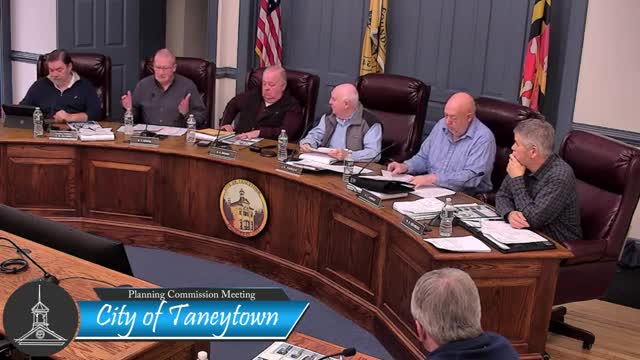Commission debates community‑village overlay, townhouses and service capacity
January 01, 2025 | Taneytown, Carroll County, Maryland
This article was created by AI summarizing key points discussed. AI makes mistakes, so for full details and context, please refer to the video of the full meeting. Please report any errors so we can fix them. Report an error »

The planning commission spent its new‑business time discussing a draft Community Village overlay (an optional form‑based tool to allow denser, mixed housing), components of Meads Crossing/Meadowbrook developments and policy questions about how to preserve small‑town character while accommodating more compact housing.
Commissioners and staff discussed how townhouses and clustered housing can provide more affordable units than typical single‑family construction, but they also raised design and long‑term community questions: how to site townhouses so they fit established neighborhoods, whether garages actually provide usable parking space and how homeowner association fees, front‑foot assessments or ongoing service charges affect affordability.
Daryl and planning staff reviewed lessons from Meads Crossing and Meadowbrook: how stormwater management was shared between developments, how ownership (HOA vs. city) and public works agreements are negotiated, and that the city expects to take over stormwater facilities only after review and acceptance. Commissioners asked for clearer upfront agreements with developers so items such as parking signage, dumpster locations and initial site signage are installed at the appropriate time during build out.
A notable concern raised by multiple commissioners was emergency service capacity. Commissioners referenced county concurrency/response reports and asked whether fire and EMS staffing and response times in Taneytown are adequate to support additional development. Staff said APFO (adequate public facilities) testing is usually performed closer to approval (preliminary plan/approval point) so that data and mitigation plans reflect current conditions; staff suggested the commission may want wider county‑level coordination to obtain more consistent APFO responses for fire/EMS than a single local volunteer company might provide.
Commissioners asked for more detailed guidance on how the town's code calculates density (the code currently uses gross acreage rather than net buildable acreage) and discussed whether a change to use net acreage would be appropriate. Staff explained that a change of that sort would require a code revision and careful treatment of mandated open‑space credits and credits for non‑buildable features such as lakes.
No formal action was taken; commissioners asked staff to refine a draft overlay, to collect clearer examples of how affordability has been implemented elsewhere, and to coordinate with county emergency services on APFO response procedures.
Commissioners and staff discussed how townhouses and clustered housing can provide more affordable units than typical single‑family construction, but they also raised design and long‑term community questions: how to site townhouses so they fit established neighborhoods, whether garages actually provide usable parking space and how homeowner association fees, front‑foot assessments or ongoing service charges affect affordability.
Daryl and planning staff reviewed lessons from Meads Crossing and Meadowbrook: how stormwater management was shared between developments, how ownership (HOA vs. city) and public works agreements are negotiated, and that the city expects to take over stormwater facilities only after review and acceptance. Commissioners asked for clearer upfront agreements with developers so items such as parking signage, dumpster locations and initial site signage are installed at the appropriate time during build out.
A notable concern raised by multiple commissioners was emergency service capacity. Commissioners referenced county concurrency/response reports and asked whether fire and EMS staffing and response times in Taneytown are adequate to support additional development. Staff said APFO (adequate public facilities) testing is usually performed closer to approval (preliminary plan/approval point) so that data and mitigation plans reflect current conditions; staff suggested the commission may want wider county‑level coordination to obtain more consistent APFO responses for fire/EMS than a single local volunteer company might provide.
Commissioners asked for more detailed guidance on how the town's code calculates density (the code currently uses gross acreage rather than net buildable acreage) and discussed whether a change to use net acreage would be appropriate. Staff explained that a change of that sort would require a code revision and careful treatment of mandated open‑space credits and credits for non‑buildable features such as lakes.
No formal action was taken; commissioners asked staff to refine a draft overlay, to collect clearer examples of how affordability has been implemented elsewhere, and to coordinate with county emergency services on APFO response procedures.
View full meeting
This article is based on a recent meeting—watch the full video and explore the complete transcript for deeper insights into the discussion.
View full meeting
